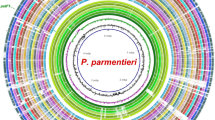Abstract
Loop-mediated isothermal amplification (LAMP) assay is a powerful and innovative gene amplification technique that specifically amplifies the target gene under isothermal conditions with a high degree of sensitivity, rapidity and specificity. The major advantage of the LAMP assay is monitoring of amplified products without the requirement of any sophisticated equipment. In the present study a real time LAMP assay was employed for rapid and real time detection of Bacillus anthracis spores spiked in 0.1 g of soil and talcum powder ranging from 2 to 107 spores. DNA was isolated from spiked soil and talcum powder using PBS containing 1% Triton X-100, and heat treatment. Isolated DNA was used as template for LAMP and PCR. LAMP amplification was obtained in 60 min under isothermal condition at 63°C by employing a set of six primers targeting the pag gene of B. anthracis. The detection limit of LAMP assay in soil and talcum powder was found to be as low as 5 spores, compared to 103 spores and 104 spores by PCR in talcum powder and soil, respectively. The findings suggest that LAMP is a more rapid and sensitive assay than PCR for detecting anthrax spores, additionally the methodology to prepare DNA from spiked samples is simple, rapid and cost effective.





Similar content being viewed by others
References
Agarwal GS, Kamboj DV, Alam SI, Dixit M, Singh L (2002) Environmental detection of Bacillus anthracis spores. Curr Sci 83:697–699
Cheun HI, Makino SI, Watarai M, Shirahata T, Uchida I, Takeshi K (2001) A simple and sensitive detection system for Bacillus anthracis in meat and tissue. J Appl Microbiol 91:421–426
Cheun HI, Makino SI, Watarai M, Erdenebaatar J, Kawamoto K, Uchida I (2003) Rapid and effective detection of anthrax spores in soil by PCR. J Appl Microbiol 95:728–733
Dragon DC, Rennie RP (2001) Evaluation of spore extraction and purification methods for selective recovery of viable Bacillus anthracis spores. L Appl Microbiol 33:100–105
Fowler RA, Sanders GD, Brayata DM, Nouri B, Gastwrith JM, Peterson D et al (2005) A comparison of vaccination and antibiotic prophylaxis against anthrax. Ann Intern Med 142:601–610
Green BD, Battsti I, Koehler TM, Thorne CB, Ivins BE (1995) Demonstration of capsule plasmid in Bacillus anthracis. Infect Immun 49:291
Jaychandran R (2002) Anthrax: biology of Bacillus anthracis. Curr Sci 82:1220–1226
Kamboj DV, Agarwal GS, Dwarkanath BS, Adhikari JS, Alam SI, Singh L (2006) Flow-cytometric analysis of Bacillus anthracis spores. Def Sci J 56:769–774
Luna VA, King D, Davis C, Rycerz T, Ewert M, Cannons A et al (2003) Novel sample preparation method for safe and rapid detection of Bacillus anthracis spores in environmental powders and nasal swabs. J Clin Microbiol 41:1252–1255
Mikessel P, Ivins BE, Ristroph JD, Dreier TM (1983) Evidence for plasmid mediated toxin production in Bacillus anthracis. Infect Immun 39:371–379
Notomi T, Okayama H, Masubuchi H, Yonekawa T, Watanabe K, Amino N, Hase T (2000) Loop-mediated isothermal amplification of DNA. Nucleic Acids Res 28:E63
Parida MM (2008) Rapid and real-time detection technologies for emerging viruses of biomedical importance. J Biosci 33:617–628
Passalacqua KD, Bergman NH (2006) Bacillus anthracis: interactions with the host and establishment of inhalational anthrax. Future Microbiol 1:397–415
Qiao YM, Guo YC, Zhang XE, Zhou YF, Zhang ZP, Wei HP et al (2007) Loop-mediated isothermal amplification for rapid detection of Bacillus anthracis spores. Biotechnol Lett 29:1939–1946
Redmond C, Pearce MJ, Manchee RJ, Berdal BP (1998) Deadly relic of the Great War. Nature 393:747–748
Ryu C, Lee K, Yoo C, Seong WK, Oh HB (2003) Sensitive and rapid quantitative detection of anthrax spores isolated from soil samples by real-time PCR. Microbial Immunol 47:693–699
Tebbe CC, Vahjen W (1993) Interference of humic acids and DNA extracted directly from soil in detection and transformation of recombinant DNA from bacteria and yeast. Appl Environ Microbiol 59:2657–2665
Zhou J, Bruns MA, Tiedje JM (1996) DNA recovery from soils of diverse composition. Appl Environ Microbiol 62:316
Acknowledgments
We are thankful to Dr. R. Vijayaraghavan, Director, Defence Research and Development Establishment, Ministry of Defense, Government of India, Dr. PVL Rao Division of Virology, Defence Research and Development Establishment, Gwalior for their support and constant inspiration and providing the necessary facilities for this study. We are also thankful to Professor R. M. Agarwal, Jiwaji University, Gwalior for his valuable support to carry out this work.
Author information
Authors and Affiliations
Corresponding author
Rights and permissions
About this article
Cite this article
Jain, N., Kumar, J.S., Parida, M.M. et al. Real-time loop-mediated isothermal amplification assay for rapid and sensitive detection of anthrax spores in spiked soil and talcum powder. World J Microbiol Biotechnol 27, 1407–1413 (2011). https://doi.org/10.1007/s11274-010-0592-3
Received:
Accepted:
Published:
Issue Date:
DOI: https://doi.org/10.1007/s11274-010-0592-3




